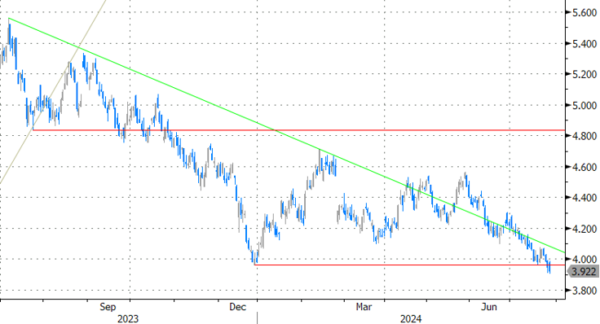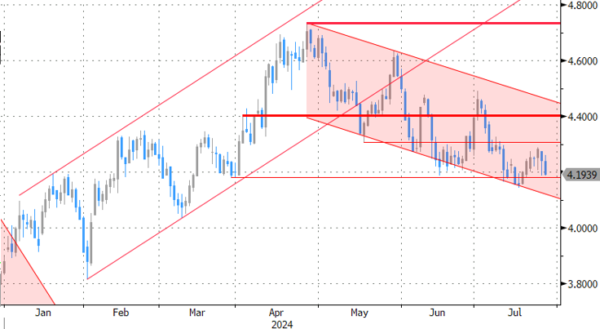Markets
Markets finally took a breather this morning after recent sharp risk-off repositioning especially in equities and interest rates. However, it doesn’t feel as if a sharp, sustained countermove is already in store. Initial ‘gains’ in yields, gradually evaporated. Equities are rebounding about 0.75% (Eurostoxx50 & S&P500) but one has the feeling that some kind of sell-on-upticks dynamics could still kick in. Investors are pondering the chances of a ‘global’ economic slowdown and the impact of any subsequent monetary policy response/easing. At least for now, markets clearly see little reason to profoundly scale back recent pricing of the start of a genuine (Fed) easing cycle in a not that distant future (September) with policy normalization to continue in Q4. Regarding the data, sentiment today was challenged by the publication of July US income and spending data and the release of the closely watched price deflators. June personal income was weaker than expected (0.2% vs 0.4% expected) and the July figure was downwardly revised. Spending (0.3% from upwardly revised 0.4 M/M in May) and the price deflators (headline 0.1% M/M and 2.5% Y/Y from 2.6%, core 0.2% M/M and 2.6% Y/Y) were very close to expectations. The reaction post the release showed that south remains the path of the least resistance for US yields. From a marginal rise just before the release, US yields currently again decline between 5.5 bps (5-y) and 4.0 bps (30-y), building on recent steepening trend. The 2-y yield (4.38%) struggles to avoid a close below the 4.40% support. German bunds slightly underperform Treasuries but yields also reversed an early modest rise with yields again ceding 3.0 bps (2-y) to 1.0 bp (30-y). The EMU 2-y swap also fails to regain the 3.0% mark (2.95%). Still, in the monthly ECB expectations survey, EMU consumers at least only see a gradually further easing of inflation (cf infra). Uncertainty on global growth also prevents any meaningful rebound in in the oil price (Brent $ 81.5 p/b).
On FX markets, the dollar still shows an unconvincing momentum. DXY declines marginally (104.26). USD/JPY initially tried to regain some further ground, but the rebound was blocked after the release of the US data (currently 153.9). EUR/USD gains marginally (1.0865). Some calm returned for hard-beaten mostly smaller & often commodity related currencies (NZD, AUD, CAD NOK, SEK) but the rebound if any mostly remains technically insignificant. The Aussie dollar (AUD/USD 0.6563) and the Norwegian krone (EUR/NOK 11.91) look best positioned for some bottoming out process. The Swiss franc (EUR/CHF 0.9584) makes a small step backward as the safe haven bid eases. UK yields also extend their decline going into next week’s BoE policy meeting (2-y -3.3 bps,10-y -5.5 bps). Sterling holds yesterday’s loss with EUR/GBP trading near 0.844. The test of the key 0.84/0.8383 support is again rejected.
News & Views
The ECB’s consumer inflation survey showed their expectations for price increases have remained unchanged. The one-year ahead gauge matched last month’s 2.8% reading, which was the lowest since September 2021. The medium-term indicator (three years forward) came in at an unaltered 2.3% and both measures remained below the perceived past inflation rate (from 4.9% to 4.5%). European consumers anticipate nominal incomes to grow at a slightly quicker pace than in May (1.4% from 1.2%) while spending over the next 12 months is seen rising by 3.3%. Their expectations for growth turned more negative, from -0.8% to -0.9% but the unemployment rate was seen slightly lower over the same period, from 10.7% to 10.6% – a series low. In June consumers expected the price of their home to increase by 2.7% over the next 12 months, which was slightly higher than in May (2.6%), and mortgage rates of 4.8% (vs 4.9% in May).
Norwegian retail sales were came in sub-par in June. Turnover dropped a whopping 5.1% m/m, the sharpest monthly drop since August 2021, to be -3% lower y/y. All categories except for sales of ICT equipment dropped significantly but, despite the size, is no reason for concern. This month’s decline followed an exceptionally strong month of May, which saw an upward revision to 4.7% m/m (from 3.2%). On a quarterly basis, sales were nevertheless up 1% compared to Q1 of this year. The Norwegian krone appreciated slightly today (EUR/NOK 11.90) but that move is at least partially inspired by a less sour/improved market sentiment compared to the previous days/weeks.
Graphs
UK 2-yr yield drops to lowest level in more than a year as markets ponder chance of BoE rate cut next week.

Brent oil struggles as markets see risk to global demand due to mediocre growth.

US 10-y yield still testing the 4.20% support area as markets prepare for genuine (Fed) easing cycle.

EUR/CHF: franc rebound taking a breather as risk-off eases (for now).










